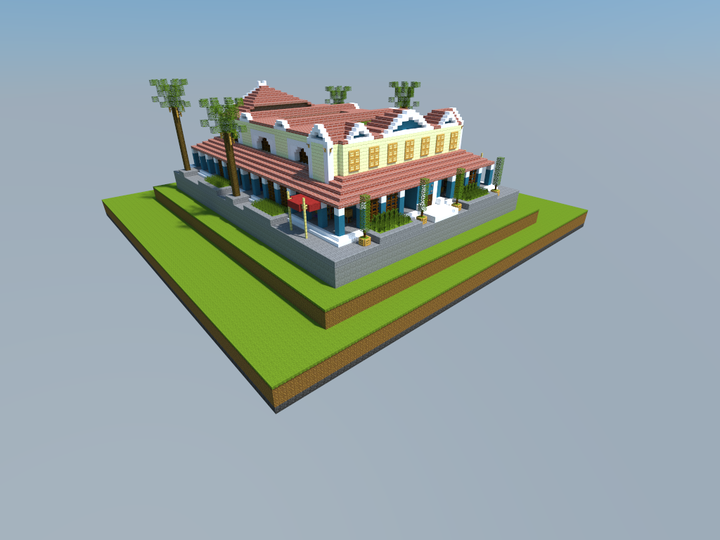- 3,283 views, 2 today
- 240 downloads, 0 today
202
This is my 1:1 recreation of the Bathhouse of Alexandria from Assassin's Creed: Origins. I know I usually post a whole description of the build accompanied by a dissertation on the historical aspect of it but I couldn't find anything specific enough to this bathhouse, so instead, enjoy reading about bathhouses in general.
Bathing played a major part in ancient Roman culture and society. Bathing was one of the most common daily activities in Roman culture, and was practiced across a wide variety of social classes. Though many contemporary cultures see bathing as a very private activity conducted in the home, bathing in Rome was a communal activity.
Some of the earliest descriptions of western bathing practices came from Greece. The Greeks began bathing regimens that formed the foundation for modern spa procedures. These Aegean people utilized small bathtubs, wash basins, and foot baths for personal cleanliness. The earliest such findings are the baths in the palace complex at Knossos, Crete, and the luxurious alabaster bathtubs excavated in Akrotiri, Santorini; both date from the mid-2nd millennium BC. They established public baths and showers within their gymnasium complexes for relaxation and personal hygiene.
Greek mythology specified that certain natural springs or tidal pools were blessed by the gods to cure disease. Around these sacred pools, Greeks established bathing facilities for those desiring healing. Supplicants left offerings to the gods for healing at these sites and bathed themselves in hopes of a cure. The Spartans developed a primitive vapor bath.
At Serangeum, an early Greek balneum (bathhouse, loosely translated), bathing chambers were cut into the hillside from which the hot springs issued. A series of niches cut into the rock above the chambers held bathers' clothing. One of the bathing chambers had a decorative mosaic floor depicting a driver and chariot pulled by four horses, a woman followed by two dogs, and a dolphin below. Thus, the early Greeks used the natural features, but expanded them and added their own amenities, such as decorations and shelves. During later Greek civilization, bathhouses were often built in conjunction with athletic fields.
The Romans emulated many of the Greeks bathing practices, Romans surpassed the Greeks in the size of their baths. As in Greece, the Roman bath became a focal center for social and recreational activity. As the Roman Empire expanded, the idea of the public bath spread to all parts of the Mediterranean and into regions of Europe and North Africa. With the construction of the aqueducts, the Romans had enough water not only for domestic, agricultural, and industrial uses, but also for their leisurely pursuits. The aqueducts provided water that was later heated for use in the baths. Today, the extent of the Roman bath is revealed at ruins and in archaeological excavations in Europe, Africa, and the Middle East.
These Roman baths varied from simple to exceedingly elaborate structures, and they varied in size, arrangement, and decoration. In taking a Roman bath, the bather induced sweating by gradually exposing himself to increasing temperatures. To accommodate this ritual, all Roman bathhouses contained a series of rooms which got progressively hotter. Most contained an apodyterium - a room just inside the entrance where the bather stored his clothes. Next, the bather progressed into the frigidarium (cold room) with its tank of cold water, the tepidarium (warm room), and finally the caldarium (hot room). The caldarium, heated by a brazier underneath the hollow floor, contained cold-water basins which the bather could use for cooling. After taking this series of sweat and/or immersion baths, the bather returned to the cooler tepidarium for a massage with oils and final scraping with metal implements. Some baths also contained a laconium (a dry, resting room) where the bather completed the process by resting and sweating.
The layout of Roman baths contained other architectural features of note. Because wealthy Romans brought slaves to attend to their bathing needs, the bathhouse usually had three entrances: one for men, one for women, and one for slaves. The preference of symmetry in Roman architecture usually meant a symmetrical facade, even though the women's area was usually smaller than the men's area because of fewer numbers of patrons. Usually solid walls or placement on opposite sides of the building separated the men's and women's sections. Roman bathhouses often contained a courtyard, or Palaestra, which was an open-air garden used for exercise. In some cases the builders made the palestra an interior courtyard, and in other cases the builders placed the palestra in front of the bathhouse proper and incorporated it into the formal approach. Sometimes the palestra held a swimming pool. Most often a colonnade outlined the palestra's edges.
Republican bathhouses often had separate bathing facilities for women and men, but by the 1st century AD mixed bathing was common and is a practice frequently referred to in Martial and Juvenal, as well as in Pliny and Quintilian. However, gender separation was restored by Emperor Hadrian.
Roman bathhouses offered amenities in addition to the bathing ritual. Ancillary spaces in the bathhouse proper housed food and perfume-selling booths, libraries, and reading rooms. Stages accommodated theatrical and musical performances. Adjacent stadia provided spaces for exercise and athletic competitions. Inside the bathhouses proper, marble mosaics tiled the elegant floors. The stuccoed walls frequently sported frescoes of trees, birds, and other pastoral images. Sky-blue paint, gold stars, and celestial imagery adorned interior domes. Statuary and fountains decorated the interior and exterior.
The Romans also developed baths in their colonies, taking advantage of the natural hot springs occurring in Europe to construct baths at Aix and Vichy in France, Bath and Buxton in England, Aachen and Wiesbaden in Germany, Baden, Austria, and Aquincum, Hungary, among other locations. These baths became centers for recreational and social activities in Roman communities. Libraries, lecture halls, gymnasiums, and formal gardens became part of some bath complexes. In addition, the Romans used the hot thermal waters to relieve their suffering from rheumatism, arthritis, and overindulgence in food and drink.
Thus, the Romans elevated bathing to a fine art, and their bathhouses physically reflected these advancements. The Roman bath, for instance, included a far more complex ritual than a simple immersion or sweating procedure. The various parts of the bathing ritual,(undressing, bathing, sweating, receiving a massage, and resting), required separated rooms which the Romans built to accommodate those functions. The segregation of the sexes and the additions of diversions not directly related to bathing also had direct impacts on the shape and form of bathhouses. The elaborate Roman bathing ritual and its resultant architecture served as precedents for later European and American bathing facilities. Formal garden spaces and opulent architectural arrangement equal to those of the Romans re-appeared in Europe by the end of the eighteenth century. Major American spas followed suit a century later.
Bathing played a major part in ancient Roman culture and society. Bathing was one of the most common daily activities in Roman culture, and was practiced across a wide variety of social classes. Though many contemporary cultures see bathing as a very private activity conducted in the home, bathing in Rome was a communal activity.
Some of the earliest descriptions of western bathing practices came from Greece. The Greeks began bathing regimens that formed the foundation for modern spa procedures. These Aegean people utilized small bathtubs, wash basins, and foot baths for personal cleanliness. The earliest such findings are the baths in the palace complex at Knossos, Crete, and the luxurious alabaster bathtubs excavated in Akrotiri, Santorini; both date from the mid-2nd millennium BC. They established public baths and showers within their gymnasium complexes for relaxation and personal hygiene.
Greek mythology specified that certain natural springs or tidal pools were blessed by the gods to cure disease. Around these sacred pools, Greeks established bathing facilities for those desiring healing. Supplicants left offerings to the gods for healing at these sites and bathed themselves in hopes of a cure. The Spartans developed a primitive vapor bath.
At Serangeum, an early Greek balneum (bathhouse, loosely translated), bathing chambers were cut into the hillside from which the hot springs issued. A series of niches cut into the rock above the chambers held bathers' clothing. One of the bathing chambers had a decorative mosaic floor depicting a driver and chariot pulled by four horses, a woman followed by two dogs, and a dolphin below. Thus, the early Greeks used the natural features, but expanded them and added their own amenities, such as decorations and shelves. During later Greek civilization, bathhouses were often built in conjunction with athletic fields.
The Romans emulated many of the Greeks bathing practices, Romans surpassed the Greeks in the size of their baths. As in Greece, the Roman bath became a focal center for social and recreational activity. As the Roman Empire expanded, the idea of the public bath spread to all parts of the Mediterranean and into regions of Europe and North Africa. With the construction of the aqueducts, the Romans had enough water not only for domestic, agricultural, and industrial uses, but also for their leisurely pursuits. The aqueducts provided water that was later heated for use in the baths. Today, the extent of the Roman bath is revealed at ruins and in archaeological excavations in Europe, Africa, and the Middle East.
These Roman baths varied from simple to exceedingly elaborate structures, and they varied in size, arrangement, and decoration. In taking a Roman bath, the bather induced sweating by gradually exposing himself to increasing temperatures. To accommodate this ritual, all Roman bathhouses contained a series of rooms which got progressively hotter. Most contained an apodyterium - a room just inside the entrance where the bather stored his clothes. Next, the bather progressed into the frigidarium (cold room) with its tank of cold water, the tepidarium (warm room), and finally the caldarium (hot room). The caldarium, heated by a brazier underneath the hollow floor, contained cold-water basins which the bather could use for cooling. After taking this series of sweat and/or immersion baths, the bather returned to the cooler tepidarium for a massage with oils and final scraping with metal implements. Some baths also contained a laconium (a dry, resting room) where the bather completed the process by resting and sweating.
The layout of Roman baths contained other architectural features of note. Because wealthy Romans brought slaves to attend to their bathing needs, the bathhouse usually had three entrances: one for men, one for women, and one for slaves. The preference of symmetry in Roman architecture usually meant a symmetrical facade, even though the women's area was usually smaller than the men's area because of fewer numbers of patrons. Usually solid walls or placement on opposite sides of the building separated the men's and women's sections. Roman bathhouses often contained a courtyard, or Palaestra, which was an open-air garden used for exercise. In some cases the builders made the palestra an interior courtyard, and in other cases the builders placed the palestra in front of the bathhouse proper and incorporated it into the formal approach. Sometimes the palestra held a swimming pool. Most often a colonnade outlined the palestra's edges.
Republican bathhouses often had separate bathing facilities for women and men, but by the 1st century AD mixed bathing was common and is a practice frequently referred to in Martial and Juvenal, as well as in Pliny and Quintilian. However, gender separation was restored by Emperor Hadrian.
Roman bathhouses offered amenities in addition to the bathing ritual. Ancillary spaces in the bathhouse proper housed food and perfume-selling booths, libraries, and reading rooms. Stages accommodated theatrical and musical performances. Adjacent stadia provided spaces for exercise and athletic competitions. Inside the bathhouses proper, marble mosaics tiled the elegant floors. The stuccoed walls frequently sported frescoes of trees, birds, and other pastoral images. Sky-blue paint, gold stars, and celestial imagery adorned interior domes. Statuary and fountains decorated the interior and exterior.
The Romans also developed baths in their colonies, taking advantage of the natural hot springs occurring in Europe to construct baths at Aix and Vichy in France, Bath and Buxton in England, Aachen and Wiesbaden in Germany, Baden, Austria, and Aquincum, Hungary, among other locations. These baths became centers for recreational and social activities in Roman communities. Libraries, lecture halls, gymnasiums, and formal gardens became part of some bath complexes. In addition, the Romans used the hot thermal waters to relieve their suffering from rheumatism, arthritis, and overindulgence in food and drink.
Thus, the Romans elevated bathing to a fine art, and their bathhouses physically reflected these advancements. The Roman bath, for instance, included a far more complex ritual than a simple immersion or sweating procedure. The various parts of the bathing ritual,(undressing, bathing, sweating, receiving a massage, and resting), required separated rooms which the Romans built to accommodate those functions. The segregation of the sexes and the additions of diversions not directly related to bathing also had direct impacts on the shape and form of bathhouses. The elaborate Roman bathing ritual and its resultant architecture served as precedents for later European and American bathing facilities. Formal garden spaces and opulent architectural arrangement equal to those of the Romans re-appeared in Europe by the end of the eighteenth century. Major American spas followed suit a century later.
| Credit | theannihilator2, pharaohcrab |
| Progress | 100% complete |
| Tags |
1 Update Logs
Update #1 : by J8054 04/14/2019 10:12:01 pmApr 14th, 2019
Fixed an error with the schematic selection where the second layer of the bathhouse floor was missing.
4290318
2


















![NOVA CONSTANTINOPOLIS: CITY OF A THOUSAND TEMPLES [1.20.4] Minecraft Map & Project](https://static.planetminecraft.com/files/image/minecraft/project/2024/376/17787794_s.jpg)



















Create an account or sign in to comment.